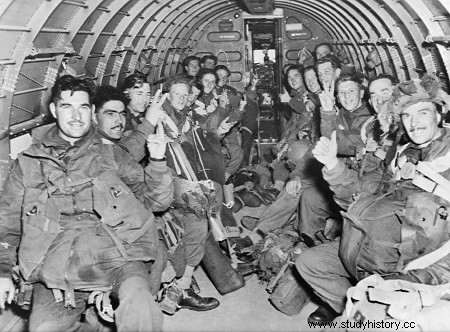
On Sunday morning, September 17, Operation Market Garden began. The weather was as expected:light wind, good visibility; a few patches of stratus had disappeared by 10 a.m.
From Dorset to Lincolnshire, at 22 airfields (8 British and 14 American), troops began to board.
These were the 38th Group of the R.A.F. and the 9th American Troop Transport Command which had prepared the flight plans, dividing the starting grounds into two sectors. The aircraft from the southern sector were to assemble over Hathfield, Hertfordshire, and those from the northern sector over March, Cambridgeshire.
The US 101st Airborne Division was to sail south to the North Fore-land, then due east above the Pas de Calais to Geel, finally heading north to reach Eindhoven. The US 82nd Airborne Division and the British 1st Airborne Division would follow the northern route through Aldeburgh and Schouwen Island to above 's-Hertogenbosch, where the stream was to split in two, each to arrive on its own objective, the Americans at Grave and Nijmegen, the English at Arnhem.
The roads were to be marked out with headlights and flashing lights at meeting and other lighthouses and coded lights on boats in the middle of the Channel; finally by colored bands fixed to the ground and colored smoke signals, as well as headlights on the landing zones. General air protection was to be provided by some thousand American and British fighter planes both during flight and during landings; armed reconnaissance had to be organized above the target area; finally, diversionary operations had been planned well beyond the sector concerned. As for the hunting grounds and the positions of the enemy Flak, they had already been bombarded. Very shortly before the landings, the surrounding barracks would also be attacked, and soon after, paratrooper dummies were to be launched west of Utrecht, Emmerich and east of Arnhem.
It was thought that the most serious danger would come from the Flak and although the air routes had been selected in such a way as to avoid the greatest concentrations of anti-aircraft guns, the loss of 40% of the planes and gliders involved had been predicted .
In reality, the Flak was not as formidable as expected. Of the 1,545 planes and 478 gliders used, very few were destroyed, and the few isolated Focke-Wulfs and Messerschmitts who were forced to attack the high cover of the fighters could not reach the transport planes. As one of the pilots of “Stirling” was to say afterwards:“Peaceful. Cake. »
Men in planes or in gliders, if they looked at the ground, could only have a sense of peace. In the streets of the villages, people stopped, looked up, waved handkerchiefs; on the North Sea, the small lifeboats rocked limply; on the coast of Holland the defenses remained silent, as if abandoned. Then, striking their eyes like an aerial photograph that suddenly comes alive, was the objective.
Gavin's 82nd division had just landed near Grave and Nijmegen, without too many hitches. One of the battalions, having landed on either side of the Grave bridge, on the Meuse, had seized it in less than an hour. Six hours later other units of the division had taken a bridge over the Meuse canal at the Waal and advanced quite far east to the edge of the Reichswald. The enemy positions had been taken with ease in a short time, and it was only after sending a battalion north towards the bridge over the Waal at Nijmegen that General Gavin encountered serious resistance.
Meanwhile, further south, Taylor's 101st Division had advanced with the same rapidity and enjoyed the same successes. As they approached Eindhoven, the gliders carrying the division had come under heavy but ineffective flak fire. Once on the ground, the Americans maneuvered quickly, easily overcoming the scattered resistance they encountered. All bridges over the Zuid Willems Vaart canal to Veghel were taken. As for the Son Bridge, on the Wilhelmine Canal, the Germans had blown it up. But the Americans of a parachute regiment were still able to cross the canal during the night. So that the next morning, the repair work on the bridge at Son was already underway and the regiment headed for Eindhoven, to the south, opening the narrow corridor through which the British armor was to attack.
This attack had already started. Installed on the roof of a factory on the bank of the canal from the Scheldt to the Meuse, General Horrocks had been able to see the flow of planes passing above him and had given his orders to the 30th corps. Soon his artillery had opened fire and the tanks of the Irish Guards had moved off to open a path to Valkenswaard and Eindhoven. Before nightfall, Americans and English were shaking hands in Eindhoven, and the corridor to the north, towards Arnhem, was free, at least as far as Nijmegen.
